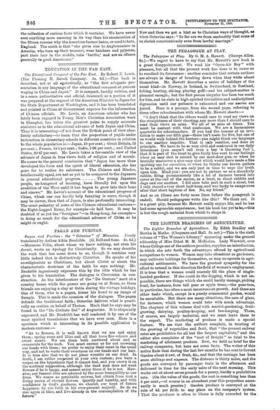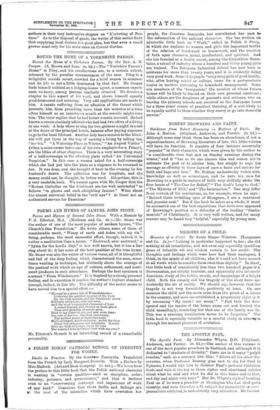THE LIGHTER BRANCHES OF AGRICULTURE.
The Lighter Branches of Agriculture. By Edith Bradley and Bertha in Mothe. (Chapman and Hall. 5s. net.)—This is the sixth volume of "The Woman's Library," appearing under the general editorship of Miss Ethel M. M. McKenna. Lady Warwick, over whose College one of the authors presides, supplies an introduction, in which she sets forth the advantages offered by agricultural occupations to women. Women may take situations as gardeners, may cultivate holdings for themselves, or may co-operate in agri- cultural settlements. We have the greatest sympathy for the effort to extend in this direction the field of woman's employment. It is true that a woman could scarcely fill the place of single- handed gardener. If she could do the digging, which is not im- possible, there are things which she could hardly manage, picking fruit, for instance, from tall pear or apple trees,—the pear-tree, in particular, has often a most inconvenient growth. And there are other tasks which, except in a purely ornamental garden, would be unsuitable. But there are many situations, the care of glass, for instance, which women could take with much advantage. The chapters of this volume deal with market-gardening, fruit- growing, dairying, poultry-keeping, and bee-keeping. These, of course, are largely technical, and we must leave them to the expert. The marketing of produce is made a special feature. We see that the authors complain, in treating of the growing of vegetables and fruit, that "the present railway rates are prohibitive for all but the largest capitalists," and the editor also complains of the "cost of freight" as fatal to the marketing of allotment produce. Now, we hold no brief for the railway companies, but here are some facts. The writer of this notice finds that during the last few months he has sent to Covent Garden about 6 cwt. of fruit, &c., and that the carriage has been seven shillings and sixpence. The distance is thirty miles, and the goods are conveyed by passenger train in the afternoon and delivered in time for the early sales of the next morning. This works out at about seven pounds for a penny, hardly a prohibitive rate. (On the value of the goods, the cost is something less than 5 per cent.,—of course in an abundant year this proportion neces- sarily is much greater.) Garden produce is conveyed at the rate of 4d. per 20 lb. to any place on the company's system. That the producer is often to blame is fully conceded by the
authors in their very instructive chapter on "Marketing of Pro- duce." As to the disposal of goods, the writer of this notice finds that supplying local dealers is a good plan, but that even a small grower must rely for his main sales on Covent Garden.



























































 Previous page
Previous page